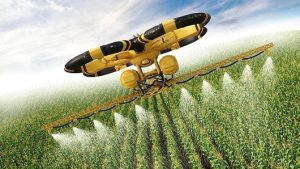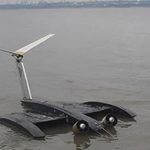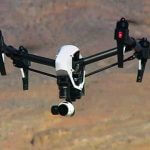Why drones and paper planes may be the future of robotics
Drones and aerial robotics are a massive industry worldwide. Chris Middleton talks to one of the world’s leading researchers, Jim Scanlan, about some extraordinary applications.
 As newspapers and governments fret about the perceived dangers of driverless cars on our roads – and the threat to 3.4 million driving jobs in the US alone – robots are taking to the skies in their millions.
As newspapers and governments fret about the perceived dangers of driverless cars on our roads – and the threat to 3.4 million driving jobs in the US alone – robots are taking to the skies in their millions.
The applications of aerial robotics are legion. For example, drones and unmanned aerial vehicles (UAVs) are helping farms to be more productive. Drones survey the land from the air with multispectral cameras, alongside autonomous tractors that move to whichever areas need fertilisation or irrigation. (For more on this see the separate report on agritech.)
Behind the robots, AI and analytics create a topographic image in data, enhanced by sensors in the ground. Over time, yields increase and crops become healthier, as farmers learn more about the conditions in which they thrive.
Nuclear power stations, wind farms, oil rigs, and other hazardous or remote sites are also being patrolled by aerial robots in this way, often linked to enterprise asset management (EAM) systems, with every component stored as a digital twin – a detailed 3D representation. Meanwhile, most of us are already familiar with drone shots in movies, and TV documentaries such as Planet Earth and Blue Planet.
In China and Dubai, smart vehicles will soon be taking to the skies with passengers, rather than cameras: unmanned, rotary-wing air taxis, such as the EHang 184, are being developed to help alleviate road congestion.
Meanwhile, the direction of most military aerospace development is also towards pilotless, autonomous or semi-autonomous units, such as the US Loyal Wingman fighter programme – developments only held back by legislative and ethical barriers.
Humanitarian bots
But the majority of drone applications are benign. For example, the first recorded air-sea rescue by robot took place in January 2018 in Australia, when a ‘Little Ripper’ drone was sent by lifeguards to drop a raft to two boys who were stranded in 10ft waves. Elsewhere, the ZipLine project sends fixed-wing robots to deliver life-saving medicines in remote areas, while cargo drones are being developed to deliver food aid, pointing to a near future of unmanned cargo flights worldwide.
The UK is a world leader in all these applications and more. Jim Scanlan is director of design at Southampton University’s Computational Engineering Design Centre (CEDC), where he manages unmanned aerial research programmes. He moved out of traditional aerospace some years ago, and is involved with a number of spin-off ventures aimed at exploiting research into UAV design process modelling.
BAe has probably made its last manned fighter jet, claims Scanlan: the future is robotic. But much of Scanlan’s own work in unmanned systems today has a greener and more humanitarian focus than warfare. He says: “We’re working on a large civilian cargo drone for delivering aid – we’re looking at South Sudan.
“The way they deliver food at the moment is with large, Russian aircraft, which are hugely expensive. They simply open the rear cargo door and chuck bags of corn and maize out the back, which is dangerous, and they lose a lot of food because the bags burst on the ground. And this is cheap stuff – half a dollar per bag of maize or flour – so they can’t afford parachutes on the packages.
“Our vision is a large, unmanned cargo drone, which cuts the cost of delivery and goes straight to where it’s needed. We need food aid to go to villages, rather than to central locations.”
It won’t be long before large, unmanned drones become the norm for international cargo deliveries, says Scanlan. “A lot of the technology infrastructure is already there. Large cargo aircraft, it would technically be easy to automate them. It’s only be a matter of time.”

What about unmanned airliners and other civilian planes? “Yeah. It’s trickier, though,” he says. “My wife was joking about the air taxis they’re flying in Dubai and would I ever get into one? I said, it’s funny that they’re coffin sized and coffin-shaped!
“A rotary-wing, battery-powered, unmanned system has lots of single points of failure, so I wouldn’t climb into one myself. And I fly lots of single-engined aircraft quite happily, because I know I could still fly if the engine failed.”
The commercial wing
For years, Scanlan worked in traditional aerospace, with R&D posts at Airbus, BAe, and elsewhere. Was it ‘reading the runes’ of the market that persuaded him to move out of his lifelong passion, traditional planes, and into robotics and autonomous systems?
“It’s more nerdy than that. I’ve spent most of my life making toy planes. I started using aero-modelling in the curriculum to teach students how to design planes, to predict performance, aerodynamic drag, lift, controllability, and so on. Over the years, those aircraft got more and more sophisticated until now they’ve become a research activity in their own right.
“Today, we build big industrial-strength UAVs – rotary wing, fixed-wing – and we continue to teach undergraduates by getting them to build their own, less sophisticated machines. In the past five years, it’s become obvious that system design now dominates, so that means putting together a coherent solution, including avionics, control software, communication software, payload software, and so on.”
Where is the most commercial interest in unmanned systems coming from?
“The low-hanging fruit is in areas that are remote, with low population density. I’m involved in a couple of spinout businesses – Callen-Lenz and FlyLogix – that are starting to offer services, for offshore gas rig and wind turbine inspection, for example. These are perfect applications, as you can do a useful job there, you can get out there quickly at low cost, and the Civil Aviation Authority [CAA] is tolerant, because it’s over the sea. It’s a low-risk environment.”
Safety and regulation


This is an important point. The rise of drones is mirrored by the growth of one company, DJI. Five years ago, it was a toy manufacturer, but today it is a multibillion-dollar enterprise making professional aerial robots.
However, the popular trend of drone usage among photographers, VR-enhanced drone racers [see video], and others, has led to them being used illegally in public places. So to what extent is the main obstacle for unmanned vehicles now legislative? How big a problem will it be to get the regulations right?
“Most rotary wing drones are DJI machines, and the company is getting worried about illegal usage,” says Scanlan. “They tend to be geofenced now [a GPS system that prevents drones from flying in restricted airspace]. We’ve been testing these to check that you can’t fly within, say, a mile of any airport.
“There have been various government consultations about drone safety and regulation, and I responded on behalf of the universities in the UK. The issue is making sure we have a light-touch system to deal with the problems of illegal usage, rather than penalising the commercial and research users.”
So what is the solution? “I think, inevitably, it’s 100 per cent registration,” says Scanlan, “so that you can at least see who’s flying them, with each drone broadcasting its identity.”
“There’s a sophisticated version of that called ADS-B [Automatic Dependent Surveillance-Broadcast]. It uses GPS information to track aircraft in real time. We could use a mini version of that, which says, ‘Here’s my identity, here’s where I am.’”
Another issue is expense. In general, hardware robotics is a costly business, although the trend in industrial machines is towards smaller, smarter platforms and ‘cobots’; over time, the app store model will dominate. This is mirrored in aerial robotics in some surprising ways. One of the most fascinating – if unlikely – developments also comes from Scanlan’s Southampton team: paper planes.
Robot paper planes
Scanlan explains why low-cost paper robots could be a major growth hotspot in the years ahead: it’s all about saving the planet. Southampton’s MAVIS project (Massive Atmospheric Volume Instrumentation System) uses desk-printable paper drones to map severe weather, natural disasters, nuclear accidents, and more.

“We’ve spent a lot of time talking to earth scientists, geologists, geographers, and particularly to climatologists. They still, amazingly, find it difficult to get the dense and reliable sets of geo-referenced data points they need to do their work. At the moment, they let off a helium balloon with a package of sensors that will give them pressure, temperature, and humidity readings. That goes up through the atmosphere and down again, giving them a linear readout. It’s better than nothing, but it’s still no good.
“Those sensor packages are expensive, they’re not biodegradable and they land all over the place, annoying people and polluting the planet. And there’s another version that our colleagues drop out of an aircraft, called FAAM – Facility for Airborne Atmospheric Measurements – which is run out of Cranfield. These things are more sophisticated, but they cost about £600 apiece, which is like chucking a laptop out every few minutes. And they never get them back.
“So the current situation is dire. So we said, ‘We can do better than that. We can make something that’s biodegradable, and genuinely so cheap that you don’t care if you never get it back, but still very sophisticated.’”
The solution is swarms of paper drones that can be dropped from helium balloons at high altitude.
“We have two versions,” says Scanlan. “First, there’s a dumb one. We can drop a swarm of these from 80,000 feet, from the stratosphere. Each craft can stream a tiny bandwidth of data back to home, saying, ‘Here’s my pressure, temperature, and altitude at these geo-referenced locations’. We can make each of these for under a fiver apiece, so we can live with losing them. They’re mostly biodegradable, apart from the batteries – and the interim solution there is safer packaging.
“The Mark 2 versions are more sophisticated, because we can steer them. You can spot areas where there needs to be a higher density of craft and data samples, and they can steer themselves towards that region. It’s spectacularly useful. Our sensor specialist colleagues are really good at miniaturising things, and they have a whole range of bio and geo-chemical sensors, and so on, that we can fit to the planes too.
“We’re very proud of the system. A colleague just went to the States, where the Americans were proudly showing their state-of-the-art rival. But theirs has no long-range communications, is far heavier, and it can’t be steered. They were very envious at what we’d achieved. A good piece of work.”
Conclusions
 It’s good to know that the UK is in the vanguard of aerial robotics, and that theoretical research is being spun out into viable commercial ventures. Robotics is taking off, in every sense. But can the UK hold onto that lead and expertise in the current political climate?
It’s good to know that the UK is in the vanguard of aerial robotics, and that theoretical research is being spun out into viable commercial ventures. Robotics is taking off, in every sense. But can the UK hold onto that lead and expertise in the current political climate?
The challenge is that the UK is a long way behind countries such as China, Japan, the US, and competitors in Western Europe when it comes to central investment in robotics – a sector that Whitehall admits will be critical to economic prosperity.
The UK is investing up to £300 million by 2020; chicken feed compared with Japan’s £161 billion over the same timescale, for example.
For obvious reasons, Scanlan is reluctant to comment, but he does say this: “The UK spends under two per cent of GDP on R&D, as opposed to the States, which spends more like three per cent, and our competitor countries, Germany and France, which spend substantially more too. However, the main way we get money is through the EPSRC [Engineering and Physical Sciences Research Council], and they’re very efficient. And luckily for us, robotics has been highlighted as a priority, so I can’t really moan.
“But of the small amount of money that the government chooses to devote to this, it is highlighted as an important area: the ‘Eight Great Technologies’, and so on. And then there’s Innovate UK funding, which is really for industry.”
But this is where another, more tricky challenge lies, suggests Scanlan. “The traditional aerospace companies, like Rolls Royce, Airbus, and British Aerospace, have a strong lobby in government, and unmanned systems are not prominent within that. There’s a thing called the Aerospace Technology Institute, which is responsible for doling out government cash to the aerospace industry. And amazingly, there’s no autonomous systems panel within that. It’s just… mad.”
If anyone is qualified to point out how the UK’s aerospace sector ought to be working, it’s Jim Scanlan, with a lifetime’s devotion to aircraft research and design, in business and academia. The conclusion is inescapable: it really is time to steer those drones into the economic hurricane.
To succeed in the long term demands both central investment and a sea-change – or perhaps an air-change – in our conservative aerospace culture.
• For more articles on robotics, AI, and automation, go to the Robotics Expert page.
• A version of this article was first published on Diginomica.
![]() Enquiries
Enquiries
07986 009109
chris@chrismiddleton.company
If you copy or quote content from this report, please acknowledge the source. Thank you.
